A Norwegian Whale Oil and Shipping Magnate
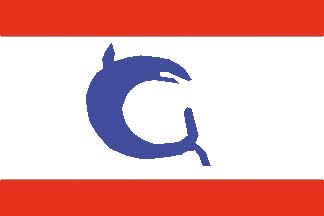
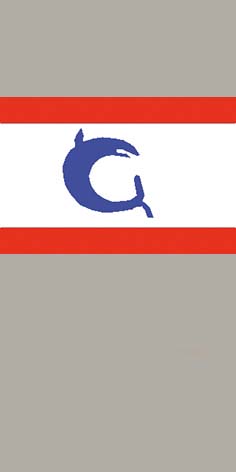 Long before Thomas Alva Edison (1847-1931) and Sir Joseph Swan (1829-914) were conducting experiments on the incandescent electric lamp, homes were lit by whale oil lamps. Sandefjord is situated at the head of a long fjord near the western outer entrance to Oslo Fjord, and has a natural deep water anchorage protected from heavy southerly seas by a narrow entrance. There has been a harbour at Sandefjord since Viking times, and a full sized Viking longship was unearthed at nearby Gokstad in 1880. The Vestfold area surrounding the fjord sent out many ships before 1850 on whaling and sealing expeditions to the Arctic and the extreme north eastern part of Norway. Expeditions loaded their stores and equipment in the quiet waters of the fjord, and two Sandefjord men became extremely rich on the profits of these expeditions, in Thor Dahl (1862-1920), and later Anders Jahre (1891-1982), the latter with his ‘Kosmos’ fleet of whale oil factory ships.
Long before Thomas Alva Edison (1847-1931) and Sir Joseph Swan (1829-914) were conducting experiments on the incandescent electric lamp, homes were lit by whale oil lamps. Sandefjord is situated at the head of a long fjord near the western outer entrance to Oslo Fjord, and has a natural deep water anchorage protected from heavy southerly seas by a narrow entrance. There has been a harbour at Sandefjord since Viking times, and a full sized Viking longship was unearthed at nearby Gokstad in 1880. The Vestfold area surrounding the fjord sent out many ships before 1850 on whaling and sealing expeditions to the Arctic and the extreme north eastern part of Norway. Expeditions loaded their stores and equipment in the quiet waters of the fjord, and two Sandefjord men became extremely rich on the profits of these expeditions, in Thor Dahl (1862-1920), and later Anders Jahre (1891-1982), the latter with his ‘Kosmos’ fleet of whale oil factory ships.
Thor Dahl
Thor Dahl was born on 28th May 1862 as the son of schoolteacher Thor Helgesen Dahl and his wife Anne Oline, daughter of a Sandefjord coastal skipper. They had married in 1857 and Thor was their first child, but Anne died when he was only two years of age, and thus it was his father that gave him his character when he was growing up. Thor Dahl started his business life at an early age by delivering goods from the shops on the narrow waterfront and pier head. He set up his own business as Thor Dahl A/S on 1st October 1887 at the age of 25 years with a large shop and ship chandlery on the waterfront. This not only fitted out the whaling expeditions but also sold all manner of goods to the local Sandefjord population.
The Dahl ‘Big Shop on the Pier Head’ sold household goods, hardware, stoves, tables, chairs, lengths of wood, wines, newspapers and magazines, fish particularly herring, butter, fruit of all kinds including apricots, pineapples, bananas, pickled ginger, strawberries and raspberries, peas and beans. In fact, Thor Dahl was running an early form of supermarket that made him into a very wealthy man, owning several large two storey wooden houses with large open verandas on the upper floor to give excellent views over the fjord. He could view from the veranda his small wooden coastal steamers delivering goods from his shop and businesses to the nearby villages and fjords.
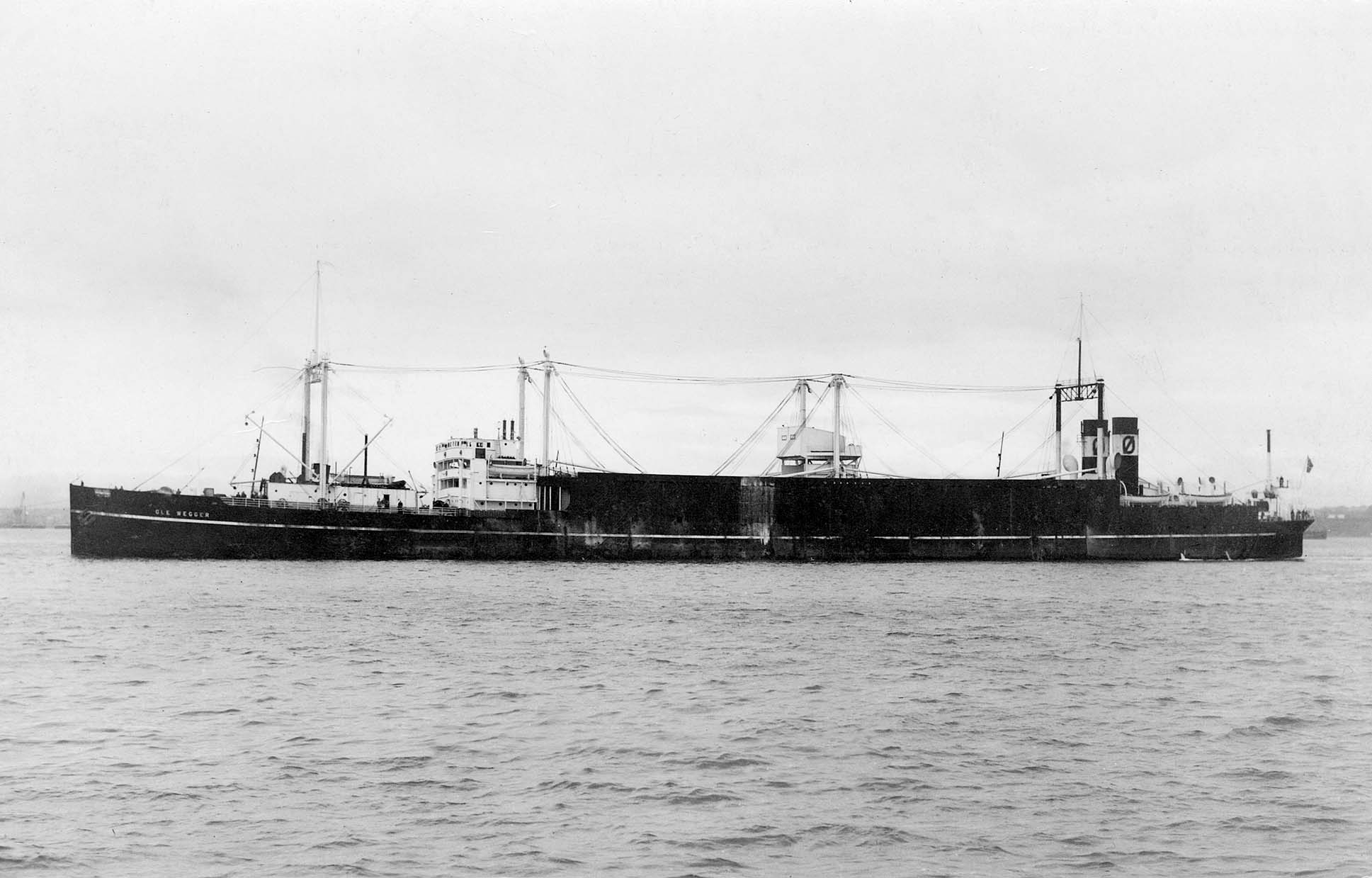
Thor Dahl also purchased Vestfold Farm in November 1900, where he also built another big house that he owned for the rest of his lifetime. One of the upper floors of another house was also rented out to his whaling manager, Ingvald Bryde. These very long whaling and sealing expeditions were initially to the Arctic, but in 1908 the Bryde and Dahl Whaling Company A/S was formed with a view to sending expeditions to the Antarctic. An expedition was sent in that year to establish a ground station at Godthul on South Georgia. Thor Dahl provided all of the stores and equipment needed for the long whaling season, including up to 700 tonnes of stores for a big floating whale factory, four tonnes of nylon ropes, thirty thousand Svend Foyn type harpoon heads weighing 134 tonnes, and a mountain of food including one hundred live pigs. Svend Foyn had invented the steam powered harpoon gun in 1865 by combining the bomb-lance, gun and steam from the engine of a steam powered whale catcher into one lethal weapon that made killing a whale into a deadly clinical business when fired from the raised bow of the catcher ship.
The Dahl And Christensen Families
Chr. Christensen (1845-1923) and his son Lars Christensen (1884-1965) were two more very important figures in Sandefjord and Norwegian whaling and shipping history. Chr. Christensen was a polar explorer in his younger years, and grew wealthy from sealing and whaling expeditions to the Arctic. Lars Christensen married Ingrid Dahl in 1910, daughter of merchant and coastal shipowner Thor Dahl, the richest citizen of Sandefjord, to continue a dynasty that would last in business for 113 years from 1887 until the white hulled Thor Dahl cargo-liners were sold off in Millennium year to CP Ships.
Lars was born on 6th April 1884 at Framnaes near Sandefjord into the whaling industry as the third youngest child of the large brood of his father, Chr. Christensen and his wife, and he later married into the Thor Dahl whaling business. His father had built bottlenose seal hunter vessels that would not be crushed by the stranglehold of deadly ice but would be squeezed above the ice. His father sent out polar explorations as well as seal and whale hunting expeditions, and also sent the first Norwegian ships in the 1894/95 season to the Antarctic to hunt for Right whales, which were not found, but instead they found Fin whales.
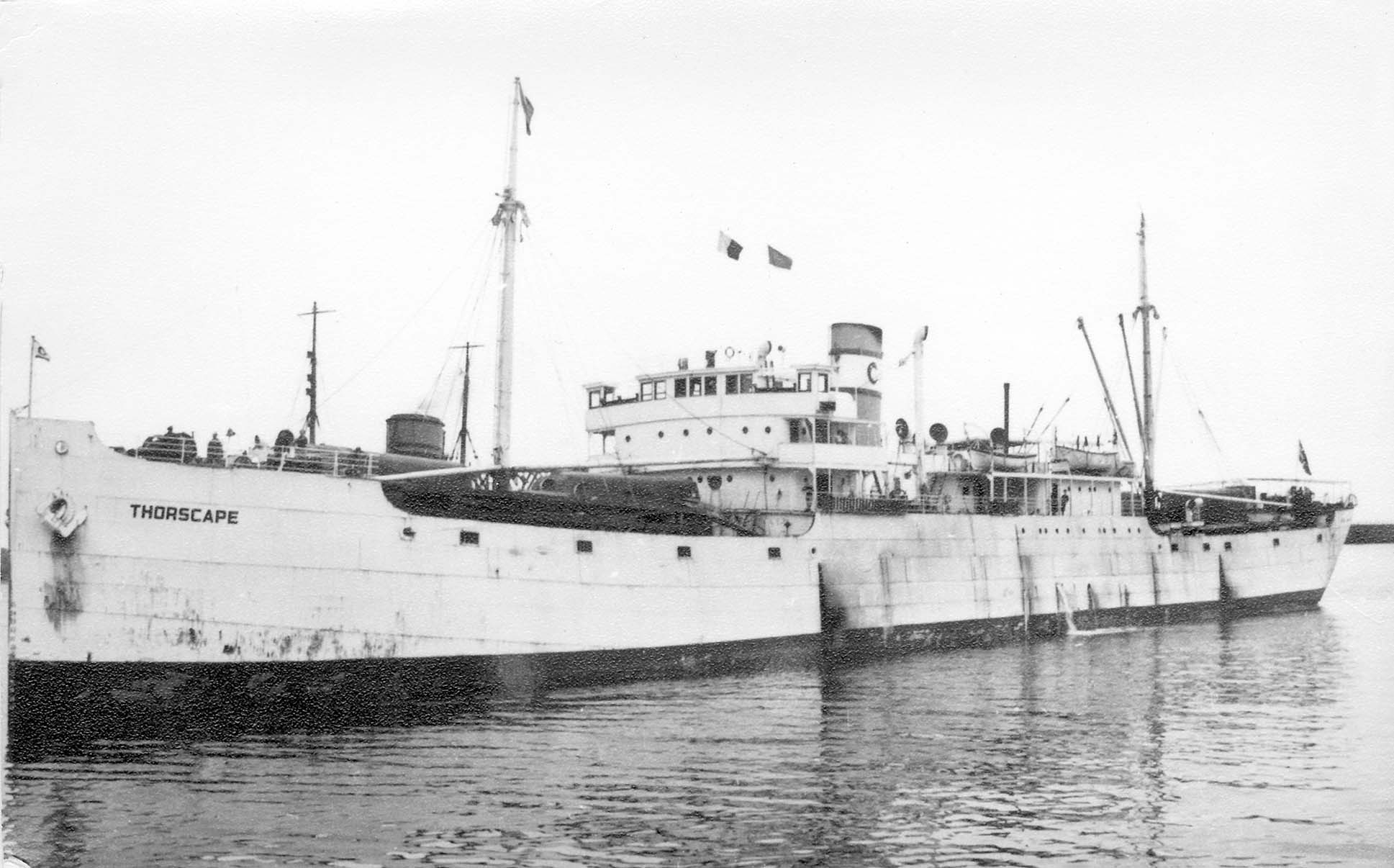
The first Norwegian floating factory, Admiralen, was sent south in 1905 by Chr. Christensen to catch Fin whales and operated with two whale catchers. She was moored for the season off the South Shetland Islands and did so well that other Norwegians followed suit with hastily converted former old passenger and cargo-liners. Admiralen of 1,517 grt had been built in 1869 by William Pile and Company at Sunderland for J. Hall of London, and was later sold and renamed Ariadne. She was purchased in 1903 for A/S Ornen (Chr. Christensen) for the 1905/06 Antarctic whaling season and then registered in 1912 under the Alaska Whaling Company A/S (Lars Christensen) for Aleutian and Pacific whaling based at Akutan and Seattle. She was sold in 1916 to Bryde and Dahl’s Whaling Company A/S (Thor Dahl A/S, manager) in 1916, and sold on in 1919 to K.H. Olsvik of Alesund and broken up during 1925.
Lars Christensen had begun his shipowning career by training in the office of his brother in law, shipowner Consul Johan Bryde. He gained further experience in 1900/01 in German and Newcastle upon Tyne shipping offices, and in the Autumn of 1901 began his studies at the Christiania Commercial College, passing in 1903. He gained further experience in German and Newcastle upon Tyne shipping offices in 1904/05, and then assisted his father and another shipowner brother in law in 1906 at Sandfjord in their offices. At the age of 23 years in 1907, Lars Christensen formed his own shipping business as A/S D/S Kamfjord for the coal trade from England and Canada to Norway. A new ship was built for this trade, and the coastal ship Varden plied from Sandefjord to Christiania (Oslo from 1912).
Whaling companies were formed by the father and son Christensen family in the United States, Canada and Chile, including Sociedad Ballenera Christensen in Chile in the Autumn of 1908, A/S Pacific (1910) for whaling from floating factory ships and a land station at Chiloe Island and the town of Corral, but only moderate success was achieved. More importantly, A/S Condor was established at Grytviken on South Georgia, which was later to become the base for most Antarctic whaling, with the extended family business of Bryde and Dahl’s Whaling Company A/S operating from there from 1908 to 1929.
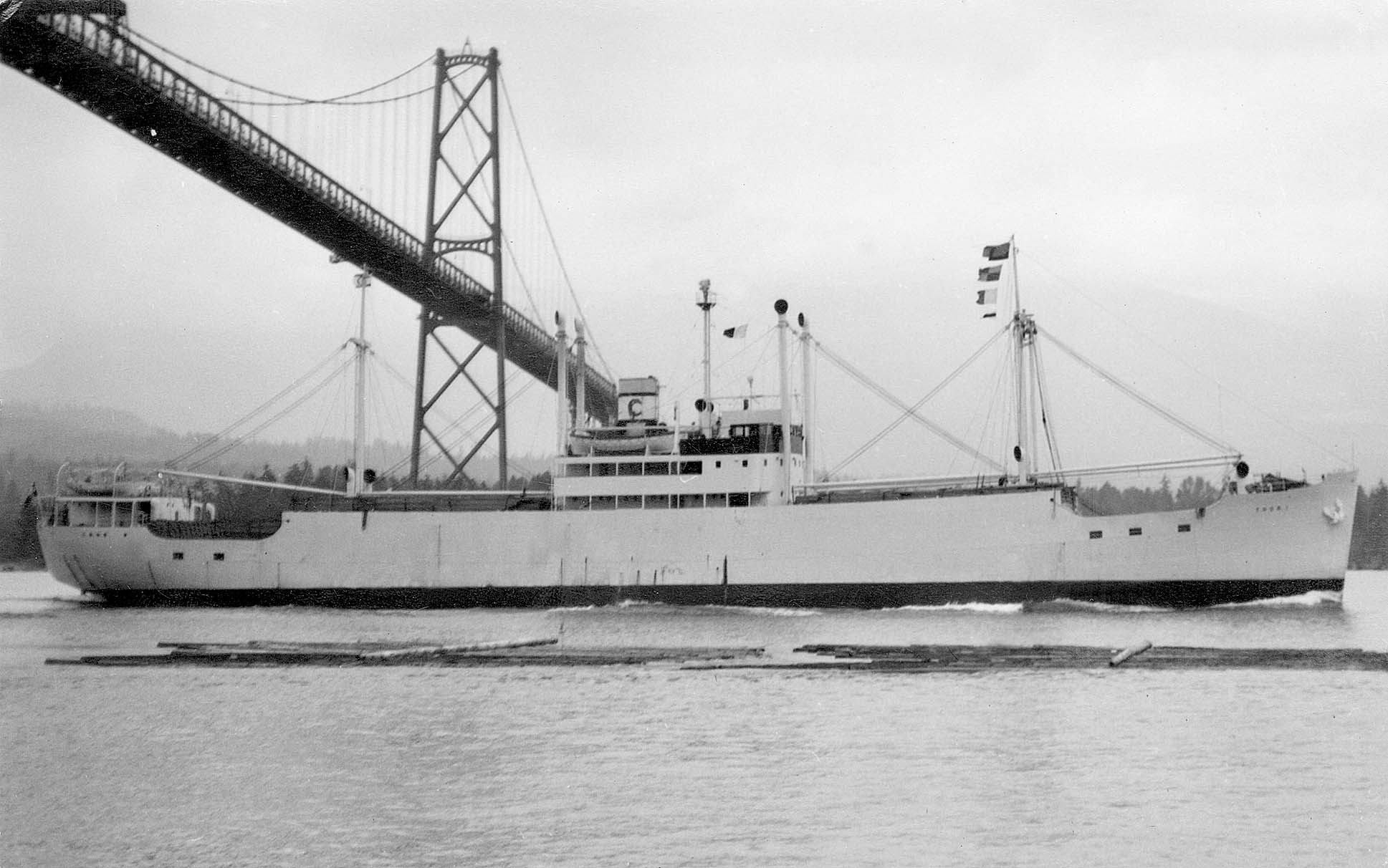
The cargo ship Imaum of 4,129 grt was launched at Belfast as yard number 226 on 25th March 1890 for Edward Bates & Son of Liverpool, and was sold in 1910 to the Bryde and Dahl’s Whaling Company A/S and converted into the whale factory ship Thor 1. She was later converted into a supply ship and broken up in 1938, and the name of Thor 1 was to be used for several more ships under the management of Thor Dahl A/S. The whale factory ship Hvalen was also taken over in 1910 for the hunting of whales off South Shetland. In 1913, at the age of 29 years, Lars Christensen was made Managing Director of the family businesses owned by his father Chr. Christensen, and of his father in law Thor Dahl and of his two sons and his two sons in law. In 1917, Lars Christensen purchased the large estate of Ranvik near Sandefjord, which remained as his home for himself, his wife Ingrid (nee Dahl), and their six children. On 22nd October 1960, Lars and Ingrid Christensen celebrated their golden wedding anniversary at Ranvik. Increased demands were made on whale oil during the Great War for the manufacture of nitro glycerine and high explosives, and also for the new use of making margarine, the substitute for the short supplies of butter.
Thor Dahl died on 15th April 1920 aged 58 years, but the family whaling business of the Dahl and Christensen families continued to expand with the purchase that year of the whale factory ship Guvernoren of 5,043 grt for A/S Odd (Chr. Christensen, Sandefjord). She had been completed as Runic in 1889 as Yard number 211 for the White Star Line as a livestock carrier, but had been converted in 1911 for the carriage of whale oil and renamed Imo. She was the cause of the head on collision with the steamer Mont Blanc on 6th December 1917 that resulted in a megabomb explosion that killed 3,500 people around Halifax (NS) harbour with another 3,000 people injured and 3,000 buildings and homes completely destroyed and thousands more blast damaged on the opposite shore at Dartmouth. Imo lost two masts, her funnel and all of her lifeboats, but drifted clear of the devastation and was later purchased by Christensen in 1920 and repaired. She fared no better after sailing from Sandefjord on 26th October 1921 for she grounded on rocks in fog twenty miles from Port Stanley on 30th November and became a total loss.
The steamer Falk of 4,390 grt was purchased in 1921 as a whale factory ship for A/S Ornen (Chr. Christensen), and had been completed as Saint Enoch for Rankin, Gilmour & Co. Ltd. of Liverpool in 1891. She was broken up in Germany in March 1936, and one of her supply tankers was the former Bowring tanker Snowflake of 2,710 grt built in 1893 by the Armstrong, Whitworth yard on the Tyne in 1893. She was renamed Thoroy by Chr. Christensen in 1925 and had a long life until broken up at Rosyth in 1953 under the name Anne de France. Chr. Christensen died in 1923, and the four old whale factory ships owned in the family business were replaced in 1928/29 by four newer converted whale factory ships for pelagic whaling on the open Antarctic Sea, and thus were not reliant on in-shore bases. These were Solglimt, Ole Wegger, Thorshammer and Torodd, the latter for A/S Odd (Thor Dahl A/S) being a conversion of the former cablelayer Colonia of 9,700 dwt built on the Tyne in 1902 to lay the first Trans Pacific cable. Ole Wegger and Thorshammer were conversions carried out by the Framnaes M.V. yard near Sandefjord of the big Eagle Oil tankers San Lorenzo and San Nazario respectively of 16,500 dwt and had been built on the Tyne and the Wear in 1914. Solglimt of 12,246 grt had been built in 1900 as the liner Potsdam for Holland America Line by the Blohm and Voss yard at Hamburg and made her last voyage across the Atlantic on 29th September 1928 before purchase by A/S Odd (Thor Dahl A/S) for conversion into a factory ship.
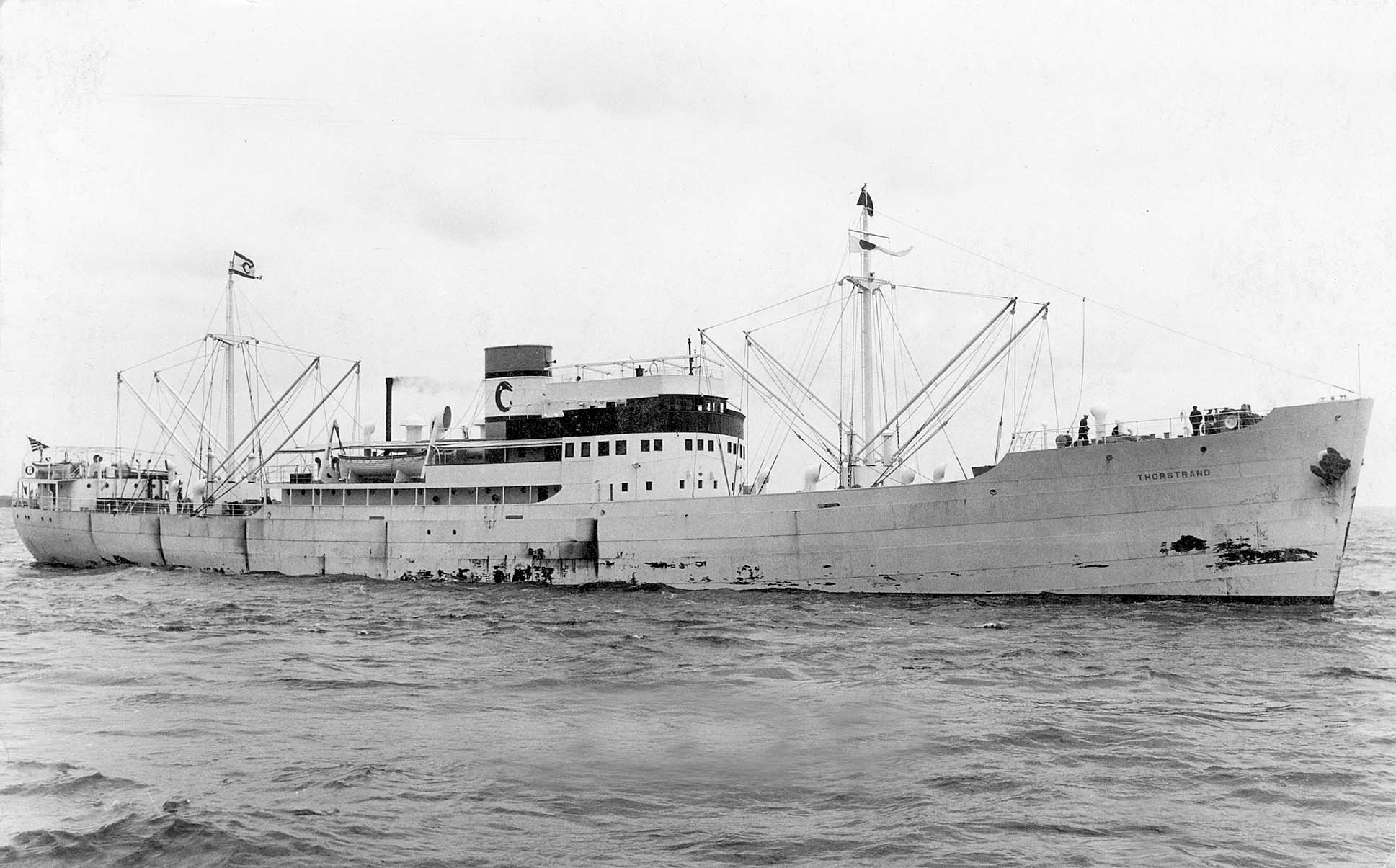
The conversions of Ole Wegger and Thorshammer required much alteration from the Eagle Oil crude oil tankers, with the hull plating built up above the aft crude oil tanks to create a long flensing deck above. This vast deck with the ‘tween deck below was used to house the factory equipment including a large number of boilers to reduce the whale blubber, accommodation for the much increased crew, and down below fuel oil outward and whale oil homeward was carried in the tanks, and expedition stores in the forward dry cargo holds. At first the centreline funnel was retained, but the problem of getting the whale carcasses to the flensing deck was solved by cutting a steep ramp through the stern, up which the carcasses were hauled to the flensing deck with twin funnels at the side of the ramp. The engine room and boiler room were modified to take the stern ramp, and the whale factory ship then had achieved its own distinctive profile and method of operation.
Thor Dahl Pelagic Whaling 1929-1967
The Thor Dahl A/S company in 1929 was essentially a holding and management company for four businesses:-
Bryde and Dahl’s Whaling Company A/S operating from both shore stations and shore based whale factory ships until 1928, and then pelagically with larger whale factory ships.
Odd A/S formed in 1923 for whaling around South Georgia.
Ornen A/S, the old Chr. Christensen company of 1903, and the pioneer of whaling with floating factory ships at Spitzbergen. The funnel colours were originally black with a central white band bearing a black letter ‘O’, before the Dahl take over.
The big ship chandlery and fitting out of whale expeditions business at Sandefjord.
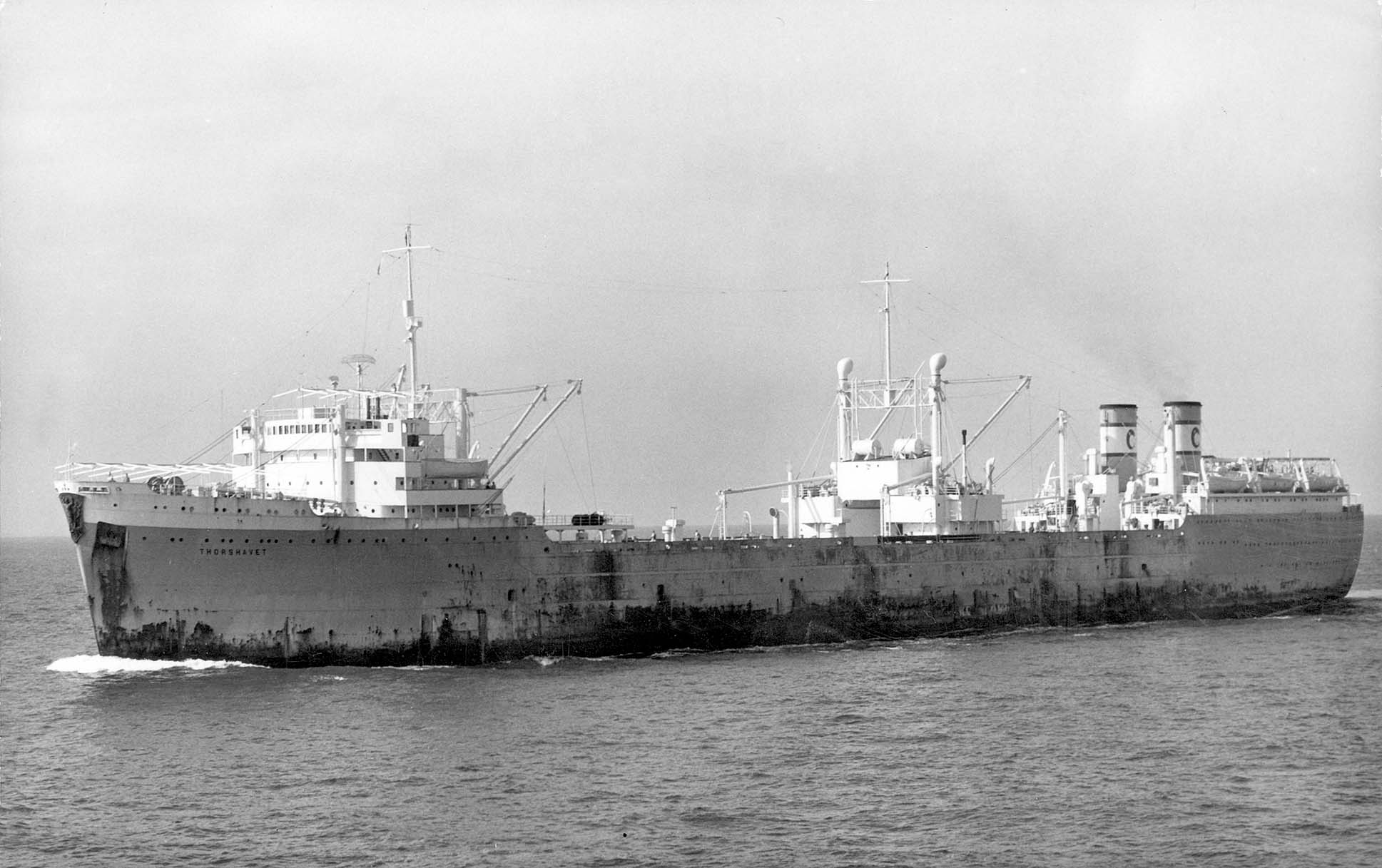
These businesses represented the largest concentration of whaling activities in the hands of a single person, Lars Christensen, in the long history of whaling. The four much bigger converted pelagic whale factory ships trebled the amount of oil and whale products produced by his fleet. The Dahl fleet consisted of four whale factory ships, 32 whale catchers i.e. eight catchers to each whale factory, and four supply ships and oil tankers heading south with fuel oil and returning with whale oil. In the 1934/35 season, Lars Christensen concluded an agreement with Unilever (Lord Leverhulme had died in 1925) for the purchase of 660,000 barrels of Norwegian whale oil at guaranteed minimum prices.
On the outbreak of war on 3rd September 1939, Thor Dahl A/S was managing thirteen vessels, comprising three whale factory shps Solglimt, Ole Wegger and Thorshammer, the oil tankers Thorshavet of 16,500 dwt, Thorshovdi of 14,710 dwt, Thorsholm of 14,800 dwt, Thorsheimer of 14,305 dwt, Thorshov of 14,305 dwt, Thorshavn of 11,040 dwt, and the supply ship Thoroy, plus two fruit carriers Thorstrand and Scebeli of 3,040 dwt, with Thor 1 of 4,050 dwt from the Framnaes yard in 1938 operating on the new Pacific Islands Transport Company service across the Pacific into west coast American ports and formed in 1938. Lars Christensen moved to be a temporary resident in the United States shortly before the fall of Norway to German forces in April 1940, from where he could better conduct the new Pacific Islands Transport Company. He worked tirelessly for the Norwegian and Allied effort as a shipping and financial expert, and he donated money to the Norwegian Seamen’s Mission to purchase a large house in San Pedro (Cal) for use as a seamen’s church.
Solglimt was captured with her attendant fleet of catchers in the Antarctic by the German surface raider Pinguin, the former Kandelfels of Hansa Line, on 14th December 1940 and sent into Bordeaux with her valuable cargo of whale oil. Ole Wegger suffered the same fate at the hands of Pinguin a month later on 14th January 1941 and again was sent into Bordeaux with her valuable cargo of whale oil. Some 60% of the Thor Dahl fleet was lost as war casualties, including the deep sea vessels Thorshavet, Thorsheimer, Thorsten, Thorstrand and Scebeli. This left only one whale factory ship, Thorshammer, afloat at the end of the war to restart pelagic whaling.
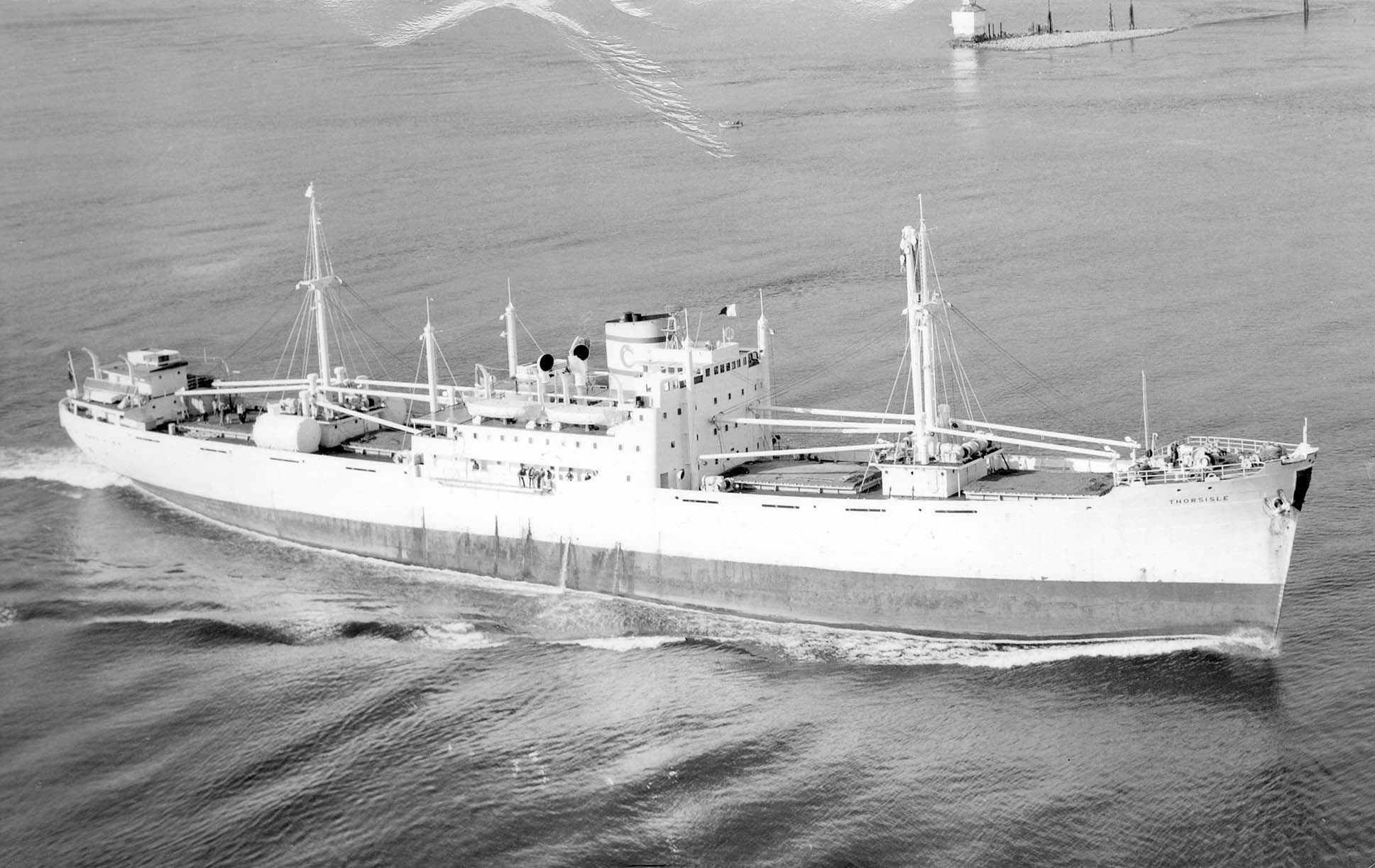
Two new floating factories of 18,000 grt were completed in 1947/48 as Thorshavet and Thorshovdi to bring the fleet of factory ships up to the pre-war level and using a brand new fleet of whale catchers. The trio produced 750,000 tonnes of whale and sperm oil during the fourteen southern seasons from 1948/49 to 1961/62. A single whale of one hundred feet in length produced 80 tonnes of whale oil and whale meat. Thorshammer was withdrawn during the 1961/62 season and broken up, Thorshavet continued until the 1966/67 season and was then sold as a floating fish factory and was lost to marine causes in 1974, and Thorshovdi continued hunting until the 1965/66 season and was then converted into an oil boring platform vessel in 1967. The worldwide ban on whaling by the International Whaling Commission was also instrumental in Salvesen of Leith giving up whale hunting at this time, with only Japan and Russia continuing whale hunting for so-called ‘scientific’ purposes, but in fact this was a cover up for their illegal whaling operations.
Tankers, Bulkers, Reefers And Cargo-Liners
The big tanker fleet that Lars Christensen had built up under the management of Thor Dahl A/S had developed from the need for the transport of fuel oil to the Antarctic and the return voyage home with whale oil. The profits from the whaling and tanker enterprises were to a large extent invested in the post-war Thor Dahl A/S tanker, cargo-liner and dry bulk fleets. The long sojourn of Lars Christensen in the United States during World War II produced a good, solid plan and preparation for the expansion of his Pacific Islands Transport (PIT) Line into west coast U.S.A. ports, and the Christensen Canada South Africa Line (CCSAL), formed in 1948 for trade between Canada and South Africa, and the Norse Oriental Line formed in 1955 for trade between Australia and Malaysia and Indonesia.

The PIT service needed to expand its presence in the South Pacific trade with a new cargo-liner, but a proposal from Alfred Clegg, principal owner of the Kerr Steamship Company Inc. of New York and San Francisco, in 1947 to start a new CCSAL liner service between the East coast of Canada and South Africa required three cargo-liners. The sisters Thorshall, Thorstrand and Thorsisle of 6,259 dwt were delivered by the Burntisland yard between November 1948 and June 1949 as yard numbers 319/320/321. General agents in Canadian ports were to be Kerr Steamships (Canada) Ltd. and their agents in South Africa, but the latter were replaced by Holland Afrika Line in 1951 in South African ports. The CCSAL service was soon extended to East African ports to become Christensen Canada Africa Line (CCAL).
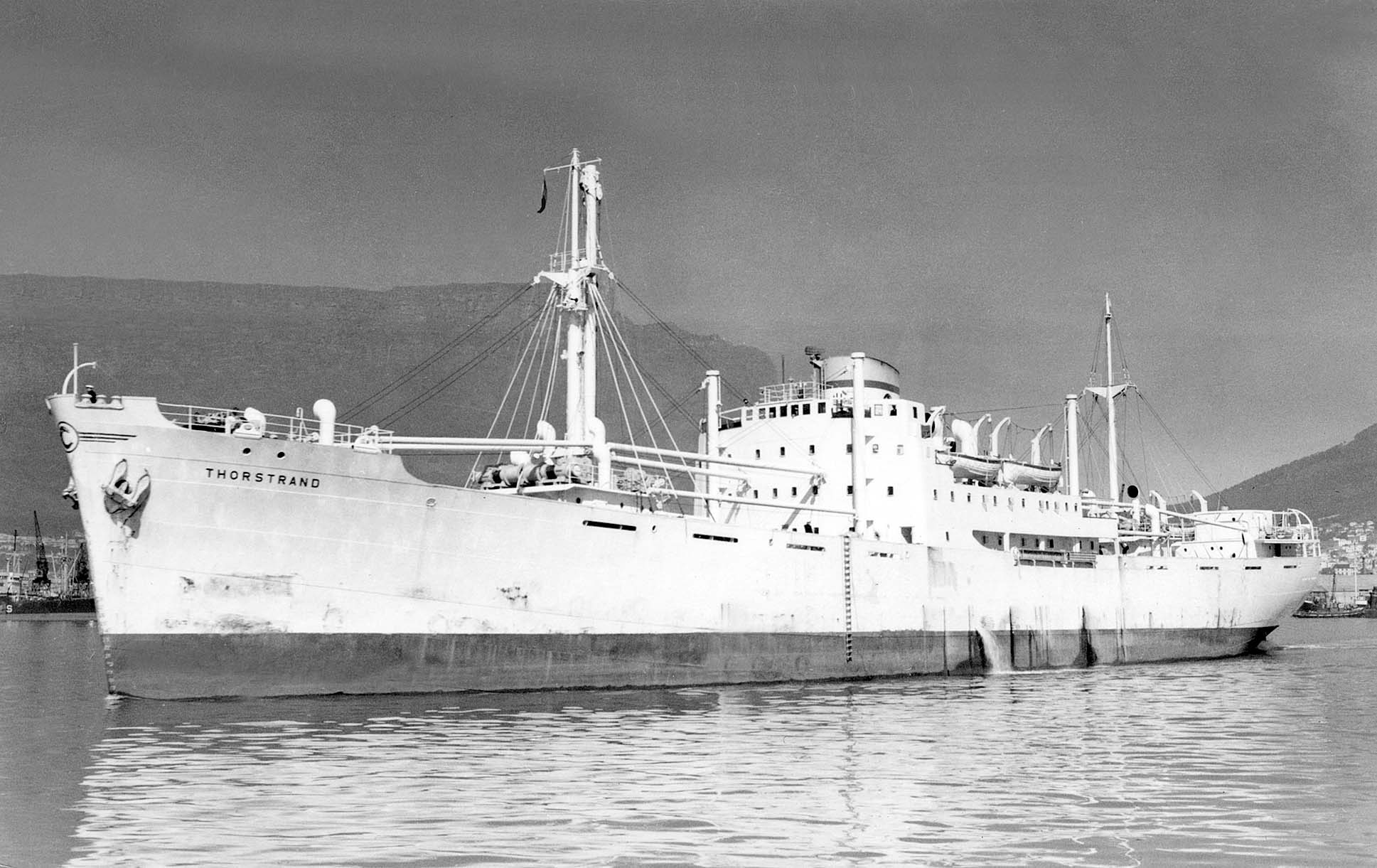
The name of Thorsisle was chosen as an indication to Thor Dahl’s friends on the Pacific coast that this vessel would be transferred to their PIT service in due course. As the first ship of the new trio would not be ready for the proposed start date of April 1948 (the opening of the 1948 shipping season from Montreal), the cargo-liner Norden of the Norden Steamship Company of Denmark was chartered from New York to South Africa for the first voyage, followed by the chartered steamer Valhall from Montreal on the second voyage, and then the recently purchased steamer Thorscape of 6,000 dwt, formerly the American steamer Philae, for the third voyage.
A few more chartered ships filled in the gaps in the 1948 monthly service with Thorscape, which also loaded Mauritian sugar at Port Louis, until the new trio were ready. The Burntisland trio continued in service during the 1950s and were joined by a new trio of 7,850 dwt, delivered from Bergens M.V. during 1952/55 as Thorsgaard (with Thorsisle then transferred to the PIT service), and Thorscape and lastly a new Thor 1 in 1955. The Burntisland trio were replaced on the CCAL service in 1959 by a new five hold trio from the Framnaes yard in Thorshope, Thorsriver and Thorstream of 8,460 dwt. They were powered by nine cylinder 2SCSA Sulzer diesels of 6,000 bhp to give service speeds of 17 knots.
The total Thor Dahl A/S fleet in 1959 of whale factory ships, whale catchers, tankers and white hulled cargo-liners amounted to 57 vessels registered under four companies of the Thor Dahl’s Whaling Company A/S, Odd A/S, Ornen A/S and Skibs Thorsholm A/S. The new cargo-liner Thorscarrier of 12,540 dwt was completed in 1959 by the Uddevallavarvet yard in Sweden and operated in CCAL service.
The Norse Oriental Line had started the service to Malaysia and Indonesia from Australia in 1955, and then used the owned Thorsdrake of 12,455 dwt, completed at Lubeck in 1956, and also chartered tonnage. The service received a permanent second hand cargo-liner in 1964 from the Ditlev-Simonsen fleet of Oslo in Vigan of 9,250 dwt, previously employed in the Pacific phosphates trades. She was renamed Thorsorient and had a service speed of sixteen knots from a seven cylinder Sulzer diesel of 6,000 bhp. Two new sister reefers were also completed in 1964 as Thorsdrott (her name meant fruit) and Thorsoy of 6,225 dwt by the Framnaes yard.

The Thor Dahl tanker fleet in 1959 comprised eight tankers of up to 18,600 dwt in Thorshavn, Thorsheimer, Thorsholm, Thorshov, Thorskog, Thorsorn, Thorsoy, Thorstar, and the new larger ‘supertanker’ Thorsvaag of 34,000 dwt completed in 1958 by the Uddevallavarvet yard in Sweden. Thorstrand of 34,000 dwt and Thorshall of 50,000 dwt followed in 1962. A trio of larger tankers was completed during 1963/66 as Thorshammer of 58,380 dwt and sisters Thorsheimer and Thorstar of 74,850 dwt. A trio of even larger tankers of 102,500 dwt was completed in 1967 by the Mitsui yard in Japan as Thorshov, Thorshovdi and Thorskog, and then by a quartet of VLCC tankers during 1970/73 as Thorsaga, Thorshammer, Thorshavet and Thorsholm from Japanese and Swedish yards. Two dry bulkers had been completed in 1962 and 1965 as Thorsodd and Thorshavn, followed by the larger Thorsdrake of 52,600 dwt in 1967 from the Haverton Hill yard of Furness Shipbuilding Co. Ltd.
Death Of Lars Christensen
The death of Consul Lars Christensen occurred on 10th December 1965 at the age of 81 years while he was staying for a short while in New York. He was laid to rest in the family vault in Sandar churchyard near Sandefjord. His affection for his native town was shown during his lifetime by the donation of a Whaling Museum in 1917 to the town, and forty years later a Maritime Museum. A magnificent metal statue of a whaleman was also gifted to the town as a reminder of the hazardous nature of whaling but also that it was the economic foundation of the whole Vestfold region. He also donated the new Olav Chapel to Sandar Parish with its typical Norwegian architecture and beautiful frescoes, in recognition of being appointed the Consul for Sandefjord to serve the local population for many years.
Lars Christensen received many high decorations during his long life, his obituary listed Commander of St. Olav’s Order, Commander of the Vasa Order, Commander of the Dannebrog Order, Commander of the Legion of Honour, and holder of many medals given by King Haakon VII of Norway. He was made one of only four honorary members of Det Norske Videnskap Akademy in Oslo in 1934, honorary member of Det Kongelige Norske Videnskabernes in Trondheim, and of Det Norske Geografiske Society, honorary Doctor of St. Olaf College in Minnesota, and honorary citizen of Granby in Canada.
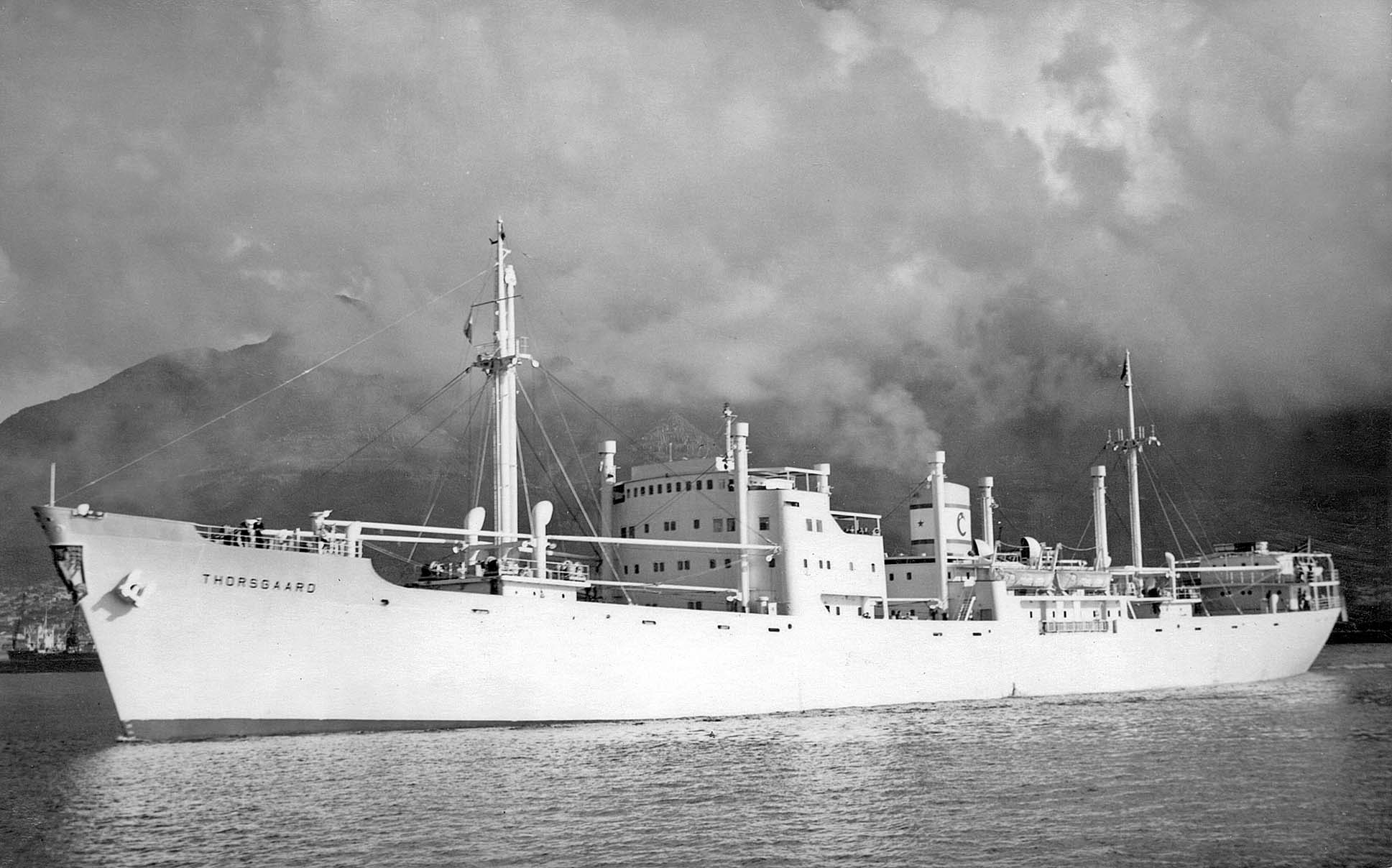
The Final Years
The OPEC oil crisis of October 1973 and the subsequent huge drop in world demand for oil and petrol had a serious effect on the Thor Dahl tanker fleet, with VLCCs laid up in the deep water of Norwegian fjords and then sold off for a fraction of their building cost, most going for scrapping. The VLCC Thorshammer was laid up at Sandefjord for many years with only a very occasional trading voyage until sold for scrap in the mid 1980s, and only her sisters Thorsaga, Thorshavet and Thorsholm managed to remain trading to the Persian Gulf. The seven year old Anders Jahre of Sandefjord tanker Jastella of 85,610 dwt was purchased in 1989. Three tankers were being traded in 1995, managed by JahreDahlBergsen of Sandefjord, the three greatest names in the long history of Norwegian tanker owning. The last trio were Thorsaga of 86,984 dwt completed by the Uddevallavarvet yard in 1980, and the product tanker near sisters of Thorsfreddy and Thorstream of around 25,000 dwt, all of this trio being sold off by 1997.
The white hulled cargo-liner fleet of Thor Dahl A/S fared much better during the years 1975 to 2000. The reefer Thorstint of 6,060 dwt served from completion at the Framnaes yard in 1968 until her sale in May 1975, and the Fred. Olsen cargo-liner Bonanza, completed in June 1953 was purchased in 1970 and renamed Thorsisle for the Pacific Islands Transport (PIT) Line and traded until her sale in October 1975 on the termination of the service. Thorswave of 13,595 dwt had been completed in early 1968 by the Framnaes yard equipped with two Stulcken heavy lift derricks and six other derricks, and made 62 round voyages on the CCAL route to South and East Africa until her sale in 1983. The main southbound cargo from Canada was newsprint, printing paper and forestry products, while the main northbound cargoes were African produce, sisal in bales, coffee in bags and chests of tea plus bulk cargoes from Lourenco Marques. Outspan oranges were carried from Cape Town to Montreal from 1960, with a gorgeous ‘Miss Outspan’ pictured on top of a slingful of orange crates as a publicity stunt for the first cargo. CCAL started to call at West African ports to fill up with cargo after East African ports were dropped after a shortfall in cargoes in the mid 1980s. Portuguese ports were also included on the northbound rotation for a few years to lift cargoes of general and containerised goods.
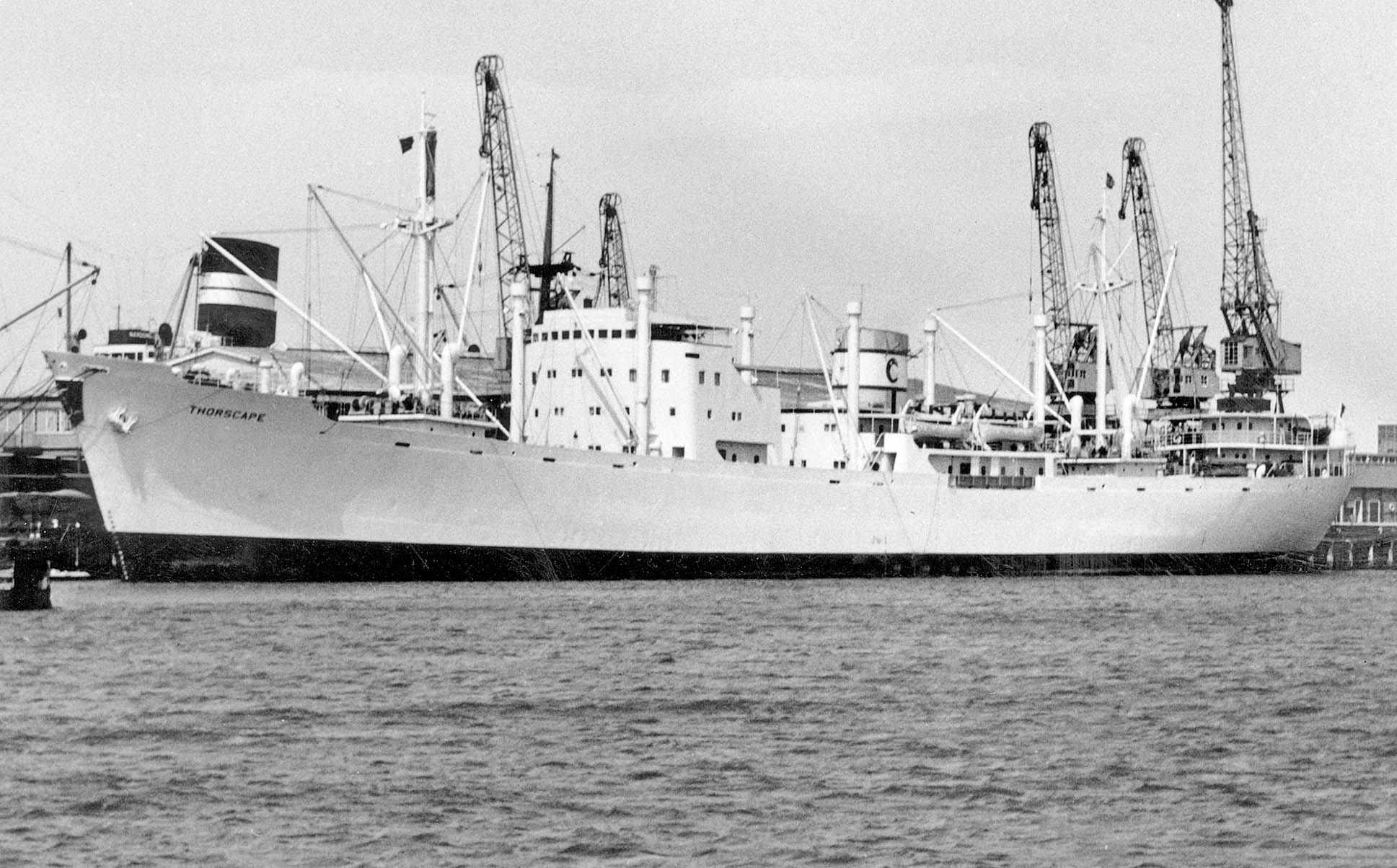
The arrival of Thorscape of 7,800 dwt at Singapore on 6th March 1976, marked the end of the Norse Oriental Line after 21 years of operation. She had been completed by the Bergens M.V. yard in 1954 and was used on CCAL service until 1961 when she was transferred to Norse Oriental Line service. Capt. Arnold Thorvaldsen pulled down the Dahl houseflag for the last time, and Thorscape was immediately sold to Pacific International Lines (PIL) of Singapore and renamed Kota Sabas, and later arrived for scrapping at Bedi in India on 9th February 1983. She had acted as a good Samaritan to Melbourne City Council on a couple of occasions when drought had hit the city, and she pumped over one thousand tonnes of fresh water from her tanks as water rationing had been introduced with a ban on car washing, garden watering and water only to be used for cooking, washing and drinking.
The last two owned sisters Thor Dahl cargo-liners used on the CCAL service from 1977 were the new pair of Thorscape and Thor 1 of 20,075 dwt from the Tamano yard in Japan of Mitsui Engineering and Shipbuilding Co. Ltd. They had a very good range of cargo handling gear with a heavy lift Stulken derrick, four electric cranes each of forty tonnes capacity arranged on two pedestals, and six other derricks. They could also carry 500 TEU of containers at a service speed of 17.5 knots powered by a seven cylinder 2SCSA B & W oil engine of 13,100 bhp. The upper ‘tween decks of numbers 2, 3 and 4 holds were insulated and cooled by modern machinery to carry 2,000 tonnes of fruit per sailing.
The pair had strengthened bows for cutting through the winter St. Lawrence ice, and the river pilots were happy to let them power through the ice in winter as they had sufficient engine power to stubbornly cut through the thick ice. The cooling of the main engines was by cooling water circulating through ballast tanks rather than from exterior intakes, as these became frequently blocked by ice. They continued to trade on CCAL service on charter in the final years up to the end of 1999, when both had made over one hundred round voyages. The cost of their maintenance was steadily increasing and their main engines were not as fuel efficient as new vessels.

The Danish four hold cargo ship Moana Pacific of 19,865 dwt and 697 TEU capacity and equipped with six pedestal cranes of 25 tonnes capacity was chartered and then owned on the CCAL service between 1990 and 1997. Three chartered ‘Astrakhan’ type vessels of 17,510 dwt in Thorsriver, Thorshope and Thorslake were ice strengthened with ro-ro facilities for the last year or two of the service on a 21 day multi-purpose rotation between the St. Lawrence and South Africa until the CCAL service was acquired by CP Ships through its Americana Shipping subsidiary on 31st August 2000.
Framnaes M.V. Shipyard
Chr. Christensen purchased a large amount of land from his sealing profits at Framnaes on the east side of the harbour opposite Sandefjord in 1892, together with three shipyards, the earliest of which had been building Arctic sealing boats from 1842. He built a large new private residence on land behind the shipyard, and renamed the merged yards as Framnaes Mek Verksted. The engineer Ole Wegger (1859-1936) was a director of the shipyard for 47 years, and it was he that created the design for the two whale factory conversions of Eagle Oil tankers carried out in 1929 by the Framnaes M.V. yard. The converted Tyne built San Lorenzo was named Ole Wegger after himself, and the Wear built San Nazario was renamed Thorshammer.
Many famous ships were built by the Framnaes yard, including the sealer Jason 495/88 that famous Norwegian polar explorer Fridtjof Nansen captained in 1888 to attempt the first crossing of Greenland. A full scale replica of the Viking longship found at Gokstad near Sandefjord in 1880 was built in 1893, and was shown at the World Columbian Exposition at Chicago of 1893. Endurance 348/12 was built for Sir Ernest Shackleton as a steam powered three masted barquentine, and she sailed to the Antarctic in 1914 on the ill fated Imperial Trans-Antarctic Expedition. The full rigged three masted sail training ship Christian Radich 663/37 is another product of the yard and is powered by an auxiliary Caterpillar diesel to give her a speed of ten knots when not under sail. I have seen her many times on her visits to the U.K. and the U.S.A., and she is well remembered in the U.K. for her starring role in the Onedin Line series of the 1970s. She has operated in the charter market since 1999 and has taken part in all of the Cutty Sark Tall Ships Races.

After the death of Chr. Christensen in 1923, his descendants and chiefly Lars Christensen owned and ran the shipyard. The yard was later extended with two building berths for vessels up to 520 feet in length, and also had two floating pontoons for repairs to vessels up to 660 feet in length. The white hulled Thor Dahl cargo-liners and reefers Thorstrand of 1938, Thor 1 of 1938, Thorshope of 1958, Thorsriver of 1959, Thorstream of 1959, Thorsdrott of 1964, Thorsoy of 1964, Thorswave of 1968 and Thorstint of 1968 were completed as well as the tanker Thorshov of 1955. The reefers Heinrich Heine and Theodor Korner of 1975, and the reefer quintet of Hilco Skater, Hilco Sprinter, Hilco Speedstar, Hilco Scamp and Hilco Skier were completed during 1979/81.
A sextet of ro-ros was completed for Tor Line as Tor Dania, Tor Nerlandia, Tor Gothia, Tor Belgica, Tor Finlandia during 1971/74 and Tor Caledonia in 1977. The ro-paxes Union Hobart and Union Lyttelton were completed in 1976 for New Zealand trading, and Melbourne Trader in 1975 for ANL of Australia, and a ferry was completed for the British Columbian Ferry Service in 1978. The big train ferry Gerointe na Sevastopol was completed in 1978 for the Bulgarian State for Black Sea service. Deep sea trawlers such as the Russian Eros 1,727/78 and several offshore oil support vessels such as Magnus Viking 2,954/82 and Martin Viking 2,707/83 were also completed. The last two vessels were completed at the yard in 1985 for Stolt-Nielsen Seaway as Seaway Harrier (Yard number 199) and Seaway Pelican (Yard number 200) for offshore oil work.
Postscript
Two energetic and strong willed men, Thor Dahl and Lars Christensen, had guided the company through most of its 113 years of existence. Sandefjord of Vestfold province was the world capital of the whaling industry. The fitting out of a whaling expedition with a prodigious amount of food, fuel and stores required much preparation, and the Dahl and Christensen families were experts in this essential process as the pelagic whale factory ships rarely entered port, save possibly for Cape Town in an emergency. The Salvesen of Leith pelagic factory ships, Southern Venturer and Southern Harvester, were also laid up in Vestfold during the summer off season, after being refitted at Middle Docks in South Shields to remove the appalling, lingering smell of the dead whale carcasses, and in readiness for the new winter whaling season.
The grey Dahl funnel colours also had a representation of a blue whale curved to form a letter ‘C’ for Christensen on a central broad white band between two narrow red bands, and with two small red five pointed stars facing fore and aft. On the early ships, the blue whale and two red stars were crudely painted up by a gang on staging. However, on the last two new cargo-liners completed by Mitsui in 1977, Thorscape and Thor 1, the process was a lot more complex than appeared. The blue whale and two red stars were marked out on a steel plate in no less than 29 circles and three straight lines. The shapes were then painted up and the rectangular plate was then welded onto the funnel to form the central white band with a red star fore and aft. The Dahl houseflag was white with a red top and bottom and the central blue whale on the white part.
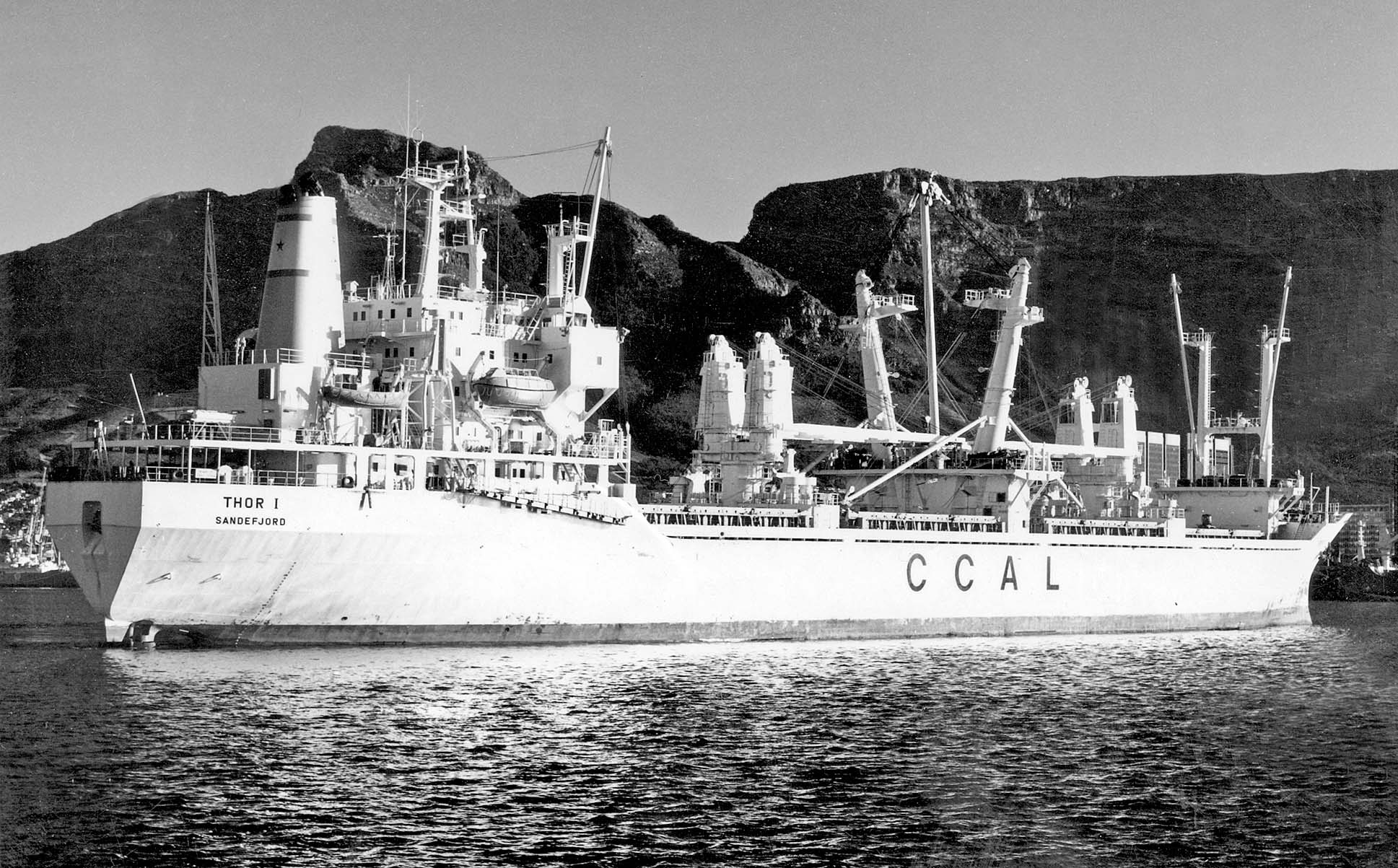
The wealth created by the Vestfold whaling industry was later invested in Thor Dahl tankers, reefers and cargo-liners, the latter serving on three distinct liner routes of the Pacific Islands Transport (PIT) Line, the Christensen Canada Africa Line (CCAL), and the Norse Oriental Line. The Dahl and the Christensen families certainly did not lead a dull existence, and are remembered today in Sandefjord by its Whaling Museum, Maritime Museum and statues in public places, all gifted to their beloved home town. The Whaling Museum gives a complete picture of the development of whaling from primitive small boat methods to modern whale catchers and whale factory ships. The preserved whale catcher Southern Actor, completed by Smith’s Dock Co. Ltd. at Middlesbrough in August 1950 for Christian Salvesen, is a static exhibit at the Whaling Museum, and entry to the ship is via your Whaling Museum ticket. She was rescued from scrapping at Bilbao in 1989 and had been restored and preserved at Sandefjord by 1996, and is still in steam today during the summer season.
Thor Dahl Management AS still exists today providing a full range of ship management services to the owners and commercial operators of ships, focussing on the container trades.

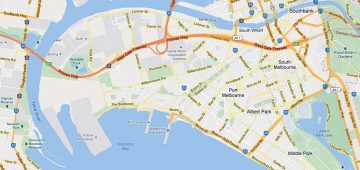



Comments
Sorry, comments are closed for this item